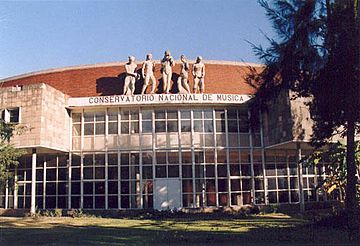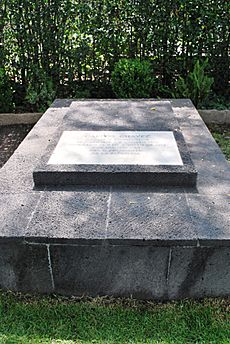Carlos Chávez facts for kids
Carlos Antonio de Padua Chávez y Ramírez (born June 13, 1899 – died August 2, 1978) was a very important Mexican composer and conductor. He also taught music, wrote about it, and started the Mexican Symphonic Orchestra.
Chávez was inspired by the ancient cultures of Mexico. His most famous work is probably his second symphony, called Sinfonía india. This piece uses special drums and instruments from the Yaqui people, an Indigenous group in Mexico.
His Life Story
Carlos Chávez was the seventh child in his family. He was born in Mexico City. His grandfather, José María Chávez Alonso, was once a governor. Carlos's father, Augustín Chávez, passed away when Carlos was only three years old.
Carlos started learning piano from his brother, Manuel. Later, he had other piano teachers like Asunción Parra and Manuel Ponce. He learned about harmony from Juan Fuentes. His family often traveled to places like Tlaxcala and Oaxaca. In these areas, the culture of Mexico's Indigenous peoples was still very strong. These trips influenced his music.
In 1916, Carlos and his friends started a cultural magazine called Gladios. This led him to work for the Mexico City newspaper El Universal in 1924. Over the next 36 years, he wrote more than 500 articles for this newspaper.
After the Mexican Revolution, a new president, Álvaro Obregón, was elected. Chávez became one of the first composers to create music that celebrated Mexican culture. He wrote ballets based on Aztec themes.
In September 1922, Chávez married Otilia Ortiz. They went on a honeymoon to Europe, visiting Vienna, Berlin, and Paris. In Paris, he met the famous composer Paul Dukas. A few months later, in December 1923, Chávez visited the United States for the first time.
He returned to New York City in September 1926 and stayed until June 1928. When he came back to Mexico, Chávez became the director of the Orquesta Sinfónica Mexicana. This orchestra was later renamed Orquesta Sinfónica de México. It was the first permanent orchestra in the country, started by a musicians' union. Chávez helped the orchestra tour through Mexico's rural areas.
In December 1928, Chávez was made director of Mexico's National Conservatory of Music. He held this job for five years. While there, he started three research groups. Two of these groups collected and studied Indigenous music. The third group looked into old and new musical scales.
In 1937, Chávez wrote a book called Toward a New Music. This was one of the first books where a composer talked about electronic music. In 1938, he conducted concerts with the NBC Symphony Orchestra. He also put on concerts at New York's Museum of Modern Art in 1940. By 1945, Chávez was known as the most important Mexican composer and conductor.
From 1947 to 1952, Chávez was the director-general of the National Institute of Fine Arts. In his first year, he created the National Symphony Orchestra. This new orchestra became Mexico's main orchestra. Throughout this time, Chávez traveled a lot for his music.
In 1953, he was asked to write a three-act opera. It was based on a story by Giovanni Boccaccio and was first called The Tuscan Players. The title changed twice, first to Pánfilo and Lauretta, then to El amor propiciado. The opera was finally performed in New York in 1957 as Panfilo and Lauretta. He revised the opera two more times, changing the title to Los visitantes (The Visitors).
From 1958 to 1959, he was a professor at Harvard University. His lectures there were published as a book called Musical Thought.
From 1970 to 1973, Chávez was the music director of the Cabrillo Festival of Contemporary Music. His orchestral piece Discovery (1969) was written for this festival.
Carlos Chávez's health declined, and he had money problems. He sold his house and moved in with his daughter Anita. He passed away peacefully on August 2, 1978, in Coyoacán, Mexico City.
His original music papers and writings are kept in the New York Public Library for the Performing Arts and the National Archive of Mexico.
His Music Style
Chávez's music didn't change styles suddenly. Instead, he kept adding new ideas to his music over time. His early works, before 1921, were mostly for piano and sounded like Romantic music. He was mainly influenced by Robert Schumann.
In 1921, he started creating music with a strong Mexican national feeling. This began with his ballet El fuego nuevo (The New Fire), which was about Aztec themes. He followed this with another ballet, Los cuatro soles (The Four Suns), in 1925.
When he lived in New York City from 1924 to 1928, Chávez became interested in abstract music. You can see this in the titles of his pieces from that time, like Polígonos (Polygons, 1923) and Energía (Energy, 1925).
A major work from this period was the ballet H. P. (which means Horse Power), also known as Caballos de vapor (1926–31). H. P. is a colorful and lively piece. It shows the influence of Igor Stravinsky but also uses Mexican folk dances like the sandunga and huapango. This Mexican style appeared often in the 1930s, especially in his Second Symphony, the Sinfonía índia (1935–36). This symphony is one of the few works where Chávez used actual Native-American melodies. The famous artist Diego Rivera designed the sets and costumes for the ballet's first show in 1932.
In the 1930s, Chávez also returned to traditional music forms like the sonata, quartet, symphony, and concerto. He wrote six symphonies. His first, called Sinfonía de Antígona (1933), was based on music he wrote for a play called Antigone. In this piece, Chávez tried to create an ancient sound using old musical styles and many wind instruments.
In his lectures at Harvard, he talked about how he used "constant rebirth" in his music. This means his music would always develop and change, like a spiral, instead of just repeating. An early example of this is Soli I (1933). He used this method regularly in his later works from the 1960s and 1970s, such as Invención I for piano (1958) and Discovery (1969).
Recordings
Carlos Chávez made many recordings, conducting his own music and music by other composers. One of his first recordings was in the 1930s for RCA Red Seal. It included his Sinfonía de Antígona and Sinfonía india.
His most famous recording was a stereo album for Everest Records. On this album, he conducted his Sinfonía india, Sinfonía de Antígona, and Sinfonía romántica. He led the Stadium Symphony Orchestra, which was the New York Philharmonic during its summer concerts. This album was first released in 1959.
In 1963, Chávez conducted the Vienna State Opera Orchestra for two recordings with pianist Eugene List. One was of his own Piano Concerto, and the other was of two piano concertos by Edward MacDowell.
In the 1950s, he also made two recordings for Decca Records in the US. On these, he conducted the Orquesta Sinfónica de México. One recording included his Suite from La hija de Cólquide (1951). Another was an album called Music of Mexico (1956), which featured three of his own works and José Pablo Moncayo's Huapango.
He also made recordings for Columbia Records. In 1961, he recorded Sergei Prokofiev's Peter and the Wolf with the Orquesta Sinfónica de México.
List of works
See also
- Grupo de los cuatro: This group of composers (Daniel Ayala Pérez, Salvador Contreras, Blas Galindo, and José Pablo Moncayo) was formed in 1935 and was influenced by Chávez.
- In Spanish: Carlos Chávez para niños




